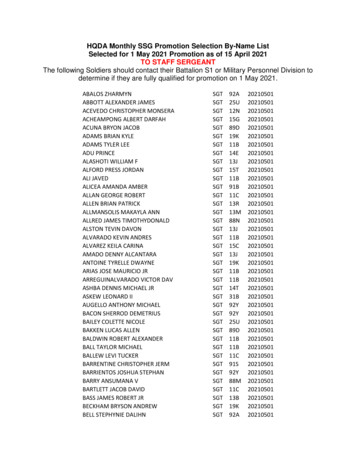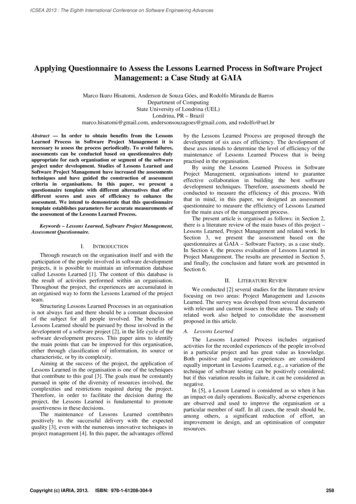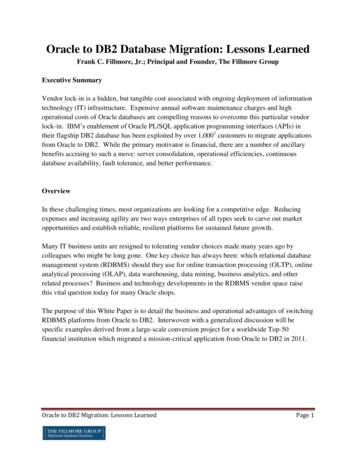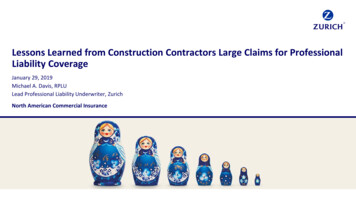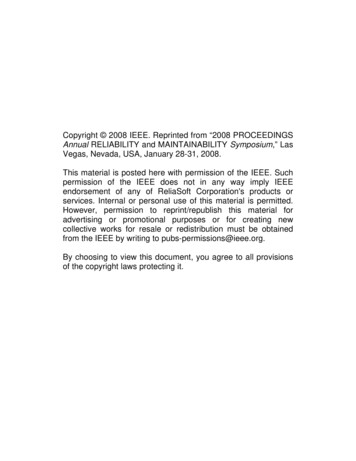
Transcription
Copyright 2008 IEEE. Reprinted from “2008 PROCEEDINGSAnnual RELIABILITY and MAINTAINABILITY Symposium,” LasVegas, Nevada, USA, January 28-31, 2008.This material is posted here with permission of the IEEE. Suchpermission of the IEEE does not in any way imply IEEEendorsement of any of ReliaSoft Corporation's products orservices. Internal or personal use of this material is permitted.However, permission to reprint/republish this material foradvertising or promotional purposes or for creating newcollective works for resale or redistribution must be obtainedfrom the IEEE by writing to pubs-permissions@ieee.org.By choosing to view this document, you agree to all provisionsof the copyright laws protecting it.
2008 Annual RELIABILITY and MAINTAINABILITY SymposiumLessons Learned for Effective FMEAsCarl S. CarlsonCarl S. CarlsonReliaSoft Corporation115 South Sherwood Village DriveTucson, Arizona 85710 USACarl.Carlson@ReliaSoft.comTutorial Notes 2008 AR&MS
SUMMARY & PURPOSECompanies are faced with intense global competition and therefore must shorten product development times and reducecosts. The four broad success factors (understanding the basics of FMEAs and Risk Assessment, applying key factors foreffective FMEAs, providing excellent FMEA facilitation and implementing a “best practice” FMEA process) will help to assuresuccess in FMEA applications.Carl S. CarlsonCarl Carlson is a consultant and instructor in the areas of FMEA, reliability program planning and other reliabilityengineering and management disciplines. He has 20 years experience in reliability engineering and management positions atGeneral Motors, most recently Senior Manager for the Advanced Reliability Group. His responsibilities included DesignFMEAs for North American operations, developing and implementing advanced reliability methods to achieve/demonstratereliability requirements and managing teams of reliability engineers. Previous to General Motors, he worked as a Research andDevelopment Engineer for Litton Systems, Inertial Navigation Division.Mr. Carlson co-chaired the cross-industry team to develop the Society of Automotive Engineers (SAE) J1739 forDesign/Process/Machinery FMEA and participated in the development of the SAE JA 1000/1 Reliability Program StandardImplementation Guide. He has also chaired technical sessions for the Reliability Track of the Annual SAE Reliability,Maintainability, Supportability and Logistics (RMSL) Symposium, was a four-year member of the Reliability andMaintainability Symposium (RAMS) Advisory Board and served for five years as Vice Chair for the SAE's G-11 ReliabilityDivision.Mr. Carlson holds a B.S. in Mechanical Engineering from the University of Michigan and completed the ReliabilityEngineering sequence from the University of Maryland's Masters in Reliability Engineering program. He is an ASQ CertifiedReliability Engineer.Table of Contents1.2.3.4.5.6.7.8.Introduction .1Understanding the Basics of FMEAs and Risk Assessment.1Applying Key Factors for Effective FMEAs.1FMEA Case Studies .3Providing Excellent FMEA Facilitation .3Implementing a “Best Practice” FMEA Process .3Conclusions .6Tutorial Visuals .7ii Carlson2008 AR&MS Tutorial Notes
1. INTRODUCTIONFew reliability tools elicit stronger responses from qualityand reliability professionals than Failure Mode and EffectsAnalysis. Reactions range from “waste of time, lack ofsupport” and “don’t want anything to do with it” all the way to“powerful tool, effective way to prevent problems” and “needsto be done across the board.”Why is there so much variation in the application of a toolthat has been around for many decades? What can be done tohelp achieve more uniformly successful results?Today’s corporations are facing unprecedented worldwidecompetition as a result of three ongoing challenges: themandate to reduce costs, faster development times and highcustomer expectations for the reliability of products andprocesses. The necessity for Reliability Assurance willcontinue to be important; however, there is increasingemphasis on Design for Reliability as a corporate strategy.One of the tools that show up on most every “short list”of Design for Reliability tools is Failure Mode & EffectsAnalysis. Most corporate and military applications requiresome form of FMEA or FMECA (Failure Mode Effects andCriticality Analysis).Yet questions remain on the overall effectiveness ofFMEA as applied in many companies and organizations today.Frankly, there are mixed results with FMEA applications.Four broad success factors are critical to uniformity ofsuccess in the application of FMEA in any company ororganization. They are:1. Understanding the basics of FMEAs and Risk Assessment2. Applying key factors for effective FMEAs3. Providing excellent FMEA facilitation4. Implementing a “best practice” FMEA process2. UNDERSTANDING THE BASICS OF FMEAS AND RISKASSESSMENTThe prerequisite for effective FMEAs is a soundknowledge of the basics of FMEA. There is no substitute forlearning these fundamentals. Once these basics have been welllearned, it is possible to understand and apply certain lessonslearned that make FMEAs highly effective.Risk assessment is helpful to identify which FMEAs willbe done as part of product and process development. Riskassessment is also an integral part of the FMEA procedure.FMEA costs money to perform and should be used where thehighest risk is anticipated.In order to identify the highest risk areas that arecandidates for FMEA, the following criteria can be examined.It is suggested that FMEAs be done when risk is associatedwith one or more of the following areas: New technology New designs where risk is a concern New applications of existing technology Potential for safety issues History of significant field problems Potential for important regulation issues Mission Critical applications Supplier CapabilityAvoid excessive time on lower risk systems.Every part of the FMEA procedure can have too much ortoo little detail. It is up to the FMEA Team and Facilitator tonavigate the challenges of detail. Too little detail can result innot identifying root causes, ineffective actions, and otherproblems. Too much detail bogs down the FMEA team andcan result in “missing the forest for the trees.”The Key is to be “Risk Conscious” and to consistentlykeep the team focused on risk; the higher the risk, the higherthe level of detail that is needed throughout the analysis.3. APPLYING KEY FACTORS FOR EFFECTIVE FMEASThe following FMEA lessons learned are the result ofpersonally supervising or participating in over a thousandFMEA projects and collaboration with many corporations andorganizations on the FMEA process and its shortcomings.There is a maxim that says, “Good judgment comes fromexperience and experience comes from poor judgment.” Thefollowing lessons learned are based on considerableexperience. Each of these lessons is from direct experience ofhow FMEAs were done wrong and how to improve theiroverall effectiveness.What are the primary ways that FMEAs can be donewrong (Mistakes) and the key factors that make for effectiveFMEAs (Quality Objectives)?3.1 Mistake # 1Based on empirical review of many FMEAs, someFMEAs do not drive any action at all; some FMEAs drivemostly testing; others drive ineffective action. The mistake is:Failure of the FMEA to drive design or processimprovements3.1.1 Quality Objective # 1The FMEA drives product design or process improvementsas the primary objectiveNote: Reliability Engineering has a multitude of tools tochoose from in driving design or process improvements. Thekey is to use the FMEA “Recommended Actions” field toidentify and execute best practice tools that can optimizedesigns. This is one of the reasons that Reliability Engineersneed to participate in FMEAs.3.2 Mistake # 2There are various methods that the FMEA team can use toidentify which failure modes (and their causes) require followup action. Some companies set pre-determined risk thresholds;others review RPNs or criticality using Pareto or othertechniques. Whatever method is used, failure to address allhigh risk failure modes (including high severity) can result inpotentially catastrophic problems or lower customersatisfaction. The mistake is:Failure of the FMEA to address all high risk failure modes3.2.1 Quality Objective # 2The FMEA addresses all high risk failure modes, asidentified by the FMEA Team, with effective and executableAction PlansNote: The emphasis on this Quality Objective is to ensurethat all of the high risk failure mode/causes are adequately2008 Annual RELIABILITY and MAINTAINABILITY SymposiumCarlson – 1
addressed with effective actions. The key is effective actionthat reduces or eliminates the risk.the FMEA team responsible to ensure that major fieldproblems are not repeated.3.3 Mistake # 33.6 Mistake # 6Some companies miss the opportunity to improve theDesign Verification Plan & Report (DVP&R) or ProcessControl Plans (PCP) based on the failure modes/causes fromthe FMEA. Some FMEA teams do not include knowledgeablerepresentatives from the test or analysis department. The resultis inadequate product testing or process control plans. Themistake is:Failure of the FMEA to improve Test/Control PlansA Key Characteristic is a feature of a material, process orpart (including assemblies) whose variation within thespecified tolerance has a significant influence on product fit,performance, service life or manufacture. Many companieshave a Key Characteristics policy. The Design FMEA canidentify Key Product Characteristics and the Process FMEAcan identify Key Process Characteristics for special controls inmanufacturing. Some companies miss this opportunity. Themistake is:FMEA omits Key Characteristics3.3.1 Quality Objective # 3The Design Verification Plan & Report (DVP&R) or theProcess Control Plan (PCP) considers the failure modesfrom the FMEANote: The FMEA team will often discover failuremodes/causes that were not part of the Design Controls orTest Procedures. The key is to ensure that the test plan(DVP&R) or Control Plan is impacted by the results of theFMEA. This can be done by including test/controlmembership on the FMEA team or through well writtenactions.3.4 Mistake # 4Empirical data shows that at least 50% of field problems canoccur at interfaces or integration with the system. Somecompanies focus on part or subsystem failures and miss theinterfaces. The mistake is:Not including system and subsystem interfaces orsubsystem integration in the FMEA3.4.1 Quality Objective # 4The FMEA scope includes integration and interfacefailure modes in both block diagram and analysisNote: Interfaces can be included as part of the item by itemanalysis or as a separate analysis. It is recommended that theFMEA Block Diagram clearly show the interfaces that are partof the FMEA scope.3.5 Mistake # 5Some companies provide no linkage between FMEAs andfield data. It takes concerted effort to integrate problemresolution databases with FMEA. Otherwise serious problemscan be repeated. The mistake is:Disconnect between FMEA and field lessons learned3.5.1 Quality Objective # 5The FMEA considers all major “lessons learned” (such ashigh warranty, campaigns, etc.) as input for failure modeidentificationNote: Field failure data can be brought into generic FMEAson a regular basis. Then, when new program-specific FMEAsare started, they benefit from field lessons learned. If genericFMEAs are not used, new FMEAs should be seeded withpotential field problems and required to show how they willnot be repeated in the new design/process. The key is to hold2 – Carlson3.6.1 Quality Objective # 6The FMEA identifies appropriate Key Characteristicscandidates, if applicable according to company policyNote: This is an underutilized element of FMEAs. SAEJ1739 and the AIAG FMEA standard use the “Classification”column to identify key product and process characteristics.3.7 Mistake # 7Many companies do FMEAs late, and this reduces theireffectiveness. FMEAs should be done concurrently with thedesign process and completed by design or process freezedates. This is a very common problem and greatly reduces theeffectiveness of FMEAs. The mistake is:Doing FMEAs late3.7.1 Quality Objective # 7The FMEA is completed during the “window ofopportunity” where it can most effectively impact theproduct or process designNote: The key to getting FMEAs done on time is to start theFMEAs on time. FMEAs should be started as soon as thedesign or process concept is determined, with the exception ofFMEAs done during trade-off studies, which should, ofcourse, be started earlier.3.8 Mistake # 8Some FMEA teams do not have the right experts on the coreteam and some do not have good attendance. Some FMEAteam members just sit in their chairs and don’t contribute toteam synergy. The mistake is:FMEAs with inadequate team composition3.8.1 Quality Objective # 8The right people participate on the FMEA teamthroughout the analysis and are adequately trained in theprocedureNote: An actual survey of Reliability Engineering internalcustomers on FMEAs showed that they thought FMEAs aretoo important not to do, but too time consuming to participatein. The FMEA facilitator must value the time of teammembers and not waste time. Additionally, people have blindspots (scotomas) and a diverse team will mitigate this issue.The key is to get the people who are knowledgeable andexperienced about potential failures and their resolutions to2008 AR&MS Tutorial Notes
actually show up at the meetings. Attendance often takesmanagement support. Team size is best kept between 4 and 8people. If the team gets too large, consider breaking up theFMEA into additional limited scope FMEAs.6. SPECIAL OR KEY CHARACTERISTICS: The FMEAidentifies appropriate Key Characteristics candidates, as inputfor the Key Characteristics selection process, if applicable dueto company policy.3.9 Mistake # 97. TIMING: The FMEA is completed during the “window ofopportunity” where it could most efficiently impact theproduct design.There are hundreds of ways to do FMEAs wrong. Somecompanies do not encourage or control proper FMEAmethodology. Training, coaching, and reviews are allnecessary to success. The mistake is:FMEAs with improper procedure3.9.1 Quality Objective # 9The FMEA document is completely filled out “by thebook,” including “Action Taken” and final risk assessmentNote: One common problem is the failure to get to the rootcauses of a failure. Expert input is necessary. Follow-upactions based on poorly defined causes will not work and theFMEA will not be successful. Another common problem is alack of follow-up to ensure that the FMEA RecommendedActions are executed and the resulting risk is reduced to anacceptable level.3.10 Mistake # 10Some companies mandate FMEAs and then do not ensurethe time is well spent. Preliminary work must be completed,meetings must be well run and efficient follow-up of high riskissues is essential. Ask the FMEA team if their time is wellspent and take action to address shortcomings. The mistake is:Lack of Efficient Use of Time3.10.1 Quality Objective # 10The time spent by the FMEA team is an effective andefficient use of time with a value-added resultNote: If this Quality Objective is met, future FMEAs will bewell attended and supported by subject matter experts andmanagement.Reference the following Figures 1 and 2, which are taken fromSAE J1739 Revised JUN2000, Appendix A and B.1. DESIGN IMPROVEMENTS: The FMEA drives DesignImprovements as the primary objective.8. TEAM: The right people participate as part of the FMEAteam throughout the analysis and are adequately trained in theprocedure. A facilitator should be utilized, as appropriate.9. DOCUMENTATION: The FMEA document iscompletely filled out “by the book,” including “Action Taken”and new RPN values.10. TIME USAGE: Time spent by the FMEA team is aneffective and efficient use of time, with a value-added result.This assumes Recommended Actions are identified asrequired and the actions are implemented.(NOTE: SPECIFIC PROGRAM REQUIREMENTS TAKEPRECEDENCE)Figure 1. Design FMEA Quality Objectives(from SAE J1739 Revised JUN2000, Appendix A)1. PROCESS IMPROVEMENTS: The FMEA drivesProcess Improvements as the primary objective, with anemphasis on Error/Mistake Proofing solutions.2. HIGH RISK FAILURE MODES: The FMEA addressesall high risk failure modes, as identified by the FMEA team,with executable Action Plans. All other failure modes areconsidered.3. Process Control PLANS: The Process Control Planconsiders the failure modes from the Process FMEA.4. INTEGRATION: The Process FMEA is integrated andconsistent with the Process Flow Diagram and the ProcessControl Plan. The Process FMEA considers the Design FMEAas part of its analysis.5. LESSONS LEARNED: The FMEA considers all major“lessons learned” (such as high warranty, campaigns, etc.) asinput for failure mode identification.2. HIGH RISK FAILURE MODES: The FMEA addressesall high risk failure modes as identified by the FMEA team,with executable Action Plans. All other failure modes areconsidered.6. SPECIAL OR KEY CHARACTERISTICS: The FMEAidentifies appropriate Key Characteristics candidates, as inputfor the Key Characteristics selection process.3. DVP&R PLANS: The Design Verification Plan and Report(DVD&R) considers the failure modes from the DesignFMEA.7. TIMING: The FMEA is completed during the “window ofopportunity” where it could most efficiently impact theproduct design.4. INTERFACES: The FMEA scope includes integration andinterface failure modes in both block diagram and analysis.8. TEAM: The right people participate as part of the FMEAteam throughout the analysis and are adequately trained in theprocedure.5. LESSONS LEARNED: The FMEA considers all major“lessons learned” (such as high warranty, campaigns, etc.) asinput for failure mode identification.9. DOCUMENTATION: The FMEA document iscompletely filled out “by the book,” including “Action Taken”and new RPN values.2008 Annual RELIABILITY and MAINTAINABILITY SymposiumCarlson – 3
10. TIME USAGE: Time spent by the FMEA team is aneffective and efficient use of time, with a value-added result.This assumes Recommended Actions are identified asrequired and the actions are implemented.(NOTE: SPECIFIC PROGRAM REQUIREMENTS TAKEPRECEDENCE)Figure 2. Process FMEA Quality Objectives(from SAE J1739 Revised JUN2000, Appendix B).4. FMEA CASE STUDIES4.1 FMEA Case Study # 1A vehicle system integrator performs a System FMEA toaddress safety and field concerns. The FMEA was started ontime, but progress was very slow due to inadequate FMEAsoftware (not user friendly, not supporting best practice, etc.).The FMEA document grew to hundreds of pages. However,due to the resulting lateness of the FMEA the Test Plans,Control Plans, Design Reviews and Design modificationswere not driven by a completed FMEA.Analysis of this case study shows that the majority of FMEAQuality Objectives were not achieved: the FMEA did notdrive Design Improvements, or Test/ Control Plans; it was toolate to be effective; and the risk rankings were assigned by oneperson instead of the team.Lessons learned include the following: FMEA softwareshould be easy to use and support FMEA best practices;FMEAs need to be completed early; program teams need tofocus on the highest risk items; and FMEAs that are too longmay become ineffective.4.2 FMEA Case Study # 2A product development team performed a Design FMEA inorder to reduce the reliability risk of an optical systemfeaturing new technology. In general, there were good resultsfrom the FMEA. However, there was one major failure modethat was not adequately addressed because it had “nosolution.” The team did not know what to do, so the issue wasnot resolved.Analysis of this case study shows that there was at least oneFMEA Quality Objective that was not achieved: the FMEAdid not address all high risk failure modes.The lesson learned from this case study is that an FMEAteam must ensure that all high risk failure modes haveeffective actions regardless of whether or not a solution isenvisioned by the team. Further studies can be commissioned,outside help can be solicited or management support can bebrought in. The FMEA facilitator should be on the alert forfailure modes that have “no solution.”4.3 FMEA Case Study # 3A medical company routinely performs Process FMEAs inorder to meet ISO compliance.Analysis of the quality of the Process FMEAs shows thatoverall, they were not value-added. Process FMEAs wereperformed regardless of whether or not a preliminary riskassessment revealed any risk in the process at all. RPNs usedto assess the risk were uniformly low. No follow-up actionswere identified; no process improvements were sought or4 – Carlsondriven. In effect, the FMEA team was only focused onmeeting compliance instead of improving the design of eitherthe product or the process. As a result, the majority of theFMEA Quality Objectives were not achieved: there were norecommended actions; the resultant RPNs indicated mostlyhigh severity, low occurrence failure modes; and the FMEAdocument was very long and of little value.The lesson learned from this case study is that the overallobjective of an FMEA should be design or processimprovement, and this objective needs to be identified andsupported by both the FMEA team and management.Compliance with standards will follow if the FMEA meetsQuality Objectives.5. PROVIDING EXCELLENT FMEA FACILITATIONA facilitator is “one who contributes structure and process tointeractions so groups are able to function effectively andmake high quality decisions.” Another definition is “a helperand enabler whose goal is to support others as they achieveexceptional performance.” Basically, a facilitator’s job is tosupport team members to do their best thinking.An FMEA facilitator is a person who is trained in bothFMEA procedures and facilitation techniques. The facilitatorleads an FMEA team to successful completion of an FMEAproject, with associated risk reduced to an acceptable level.The primary FMEA facilitation skills are: Brainstorming and Probing Questions Encouraging Participation Active Listening Controlling Discussion Making Decisions Conflict Management Managing Level of Detail Managing TimeThe importance of expert facilitation to effective results ofFMEAs cannot be overstated.Good FMEA facilitators drive the team through the process,saving valuable time and ensuring effective results. They helpsort the insignificant input from those inputs that affectproduct and process reliability and safety.6. IMPLEMENTING A “BEST PRACTICE” FMEAPROCESSWithout an effective FMEA process, actual FMEA resultswill depend on individual personalities and the whims ofvarying company priorities. If participants happen to beknowledgeable in the application of FMEA and have the timeto invest in FMEA team meetings, then it may be successful.If not, it may not be as successful.Ten tasks are outlined that need to be established andoperational within any company that aspires to achievinguniformly positive results in their application of FMEA. Theentire process is presented graphically in Figure 3.2008 AR&MS Tutorial Notes
EFFECTIVE FMEA PROCESSPlanning StagePerforming FMEAs Stage1ADevelop &ExecuteFMEAStrategicPlan1BDevelop &ExecuteFMEAResourcePlanReview StageProgram gram-SpecificFMEAsProgram BDevelopProgramSpecificFMEAsImplementationStage6.3 Program-Specific FMEAs75FMEA QualityAuditsTest &FieldFailuresExecute Actionsto Reduce/Eliminate Risk6SupplierFMEAsLinkage toOther8 Processes9To perform each generic FMEA, it will be necessary tocomplete steps 1 through 4 of the “Basic FMEA Steps”outlined in Figure 4. (Note: Step 4 of Figure 4 is onlycompleted up to design or process controls.)Integrated Software Support10Figure 3. Effective FMEA Process.6.1A FMEA Strategic PlanAs with any significant project, it is important to developand follow a strategic plan that will guide the organization’sefforts. Some of the key decisions that management mustmake regarding FMEA policy include the type of FMEAs tobe performed (e.g. Design, Process, Equipment, etc.), thetiming of FMEAs (e.g. prior to design freeze) and theselection criteria (e.g. new technology, new applications, etc.).Additional strategic management decisions that relate toother aspects of an effective FMEA process will be describedin the following sections.This is where the bulk of the FMEA work is performed.Program-specific FMEAs focus on specific applications andcan either be done from the beginning or tailored from ageneric FMEA. They should be performed by a team made upof the right experts to examine the design or process andfollow the directions from FMEA strategic planning.To be successful, FMEA teams should be well staffed(between 4 to 8 members are recommended, depending onFMEA scope and complexity) and trained. Their work shouldbe well facilitated and executed during the “window ofopportunity” that maximizes the impact of the analysis toimprove the design or process.To perform each program-specific FMEA it will benecessary to complete steps 1 through 10 of the “Basic FMEASteps” outlined in Figure 4.For each Generic FMEA (complete 4 steps -- the 4th step upto design or process controls)For each Program-Specific FMEA (complete 10 steps)1.2.3.Assign FMEA facilitator and teamEstablish FMEA timing and scopeGather relevant documentation (Generic FMEAs ifavailable, past FMEAs from Archive and all otherneeded preliminary work)4. Perform FMEA analysis (according to FMEAstandard) up through Recommended Actions5. Provide input to DVP&R or Process Control Plan6. Review risk and Recommended Actions withmanagement (per FMEA Strategic Planning)7. Update FMEA project tracking (per FMEAStrategic Planning)8. Execute Recommended Actions and do new riskassessment9. Review and approve all critical Supplier FMEAs(per FMEA Quality Objectives)10. Ensure risk reduced to acceptable level and FMEAis completed “by the book.”6.1B FMEA Resource PlanTogether with the development of the FMEA Strategic Plan,management must also make decisions to ensure that therequired resources will be available to all FMEA teams. Alongwith decisions about FMEA software and meeting facilities,key questions include the use and staffing of FMEAfacilitators, ownership of FMEA documents and the FMEAprocess and FMEA training.Strong support of management is vital to both short- andlong-term success of FMEAs in any company. I would go sofar as to say that without solid management support, FMEAswill fall far short of their potential as effective problemprevention tools.Such support is often led by an FMEA champion at theexecutive level, who helps to generate support at the stafflevel, advocates for an FMEA budget and process and sees tothe staffing, training, business process, standards,management reviews and quality audits.6.2 Generic FMEAs (optional)The development of generic FMEAs may be part of theorganization’s Strategic Plan. They contain both historic(empirical) and potential failure modes, effects, causes andcontrols, and are done at the generic level of the system,subsystem or component. It is important to keep them updatedwith test and field data and for new technology.Once accomplished, generic FMEAs can save considerabletime in the performance of program-specific FMEAs. Theyare also useful in support of concept trade-off studies.Figure 4. Basic FMEA Steps.6.4 Management Reviews (sometimes called Failure ReviewBoard)Many organizations have a Failure Review Boardestablished to review and address high risk issues discoveredduring test or field phases. High risk issues identified fromFMEAs should also be included in the review format. Thisensures management understanding, buy-in, support andadequacy. In addition, FMEA reports and charts can begenerated to provide valuable status per the FMEA StrategicPlan.It is useful to have the design owner present the FMEA highrisk item to the Failure Review Board in order to bring propercontext and ownership to the issue.2008 Annual RELIABILITY and MAINTAINABILITY SymposiumCarlson – 5
6.5 Quality AuditsEffective process models inevitably include a feedback loopto “improve the process” by incorporating both positive andnegative feedback. An effective FMEA process includes bothFMEA quality surveys (of the internal customer of the FMEA)and FMEA quality audits (in-person audits of completed ornearly completed FMEAs done by the FMEA manager).FMEA quality surveys and audits are based on the FMEAQuality Objectives outlined in Figures 1 and 2. They providevaluable information to strengthen what works and addressshortcomings.Having personally done hundreds of FMEA Quality Audits,I believe this is one of the most important steps to achieving auniformly successful FMEA application. Audits take aboutone hour each and provi
The FMEA scope includes integration and interface failure modes in both block diagram and analysis Note: Interfaces can be included as part of the item by item analysis or as a separate analysis. It is recommended that the FMEA Block Diagram clearly show the interfaces that are


